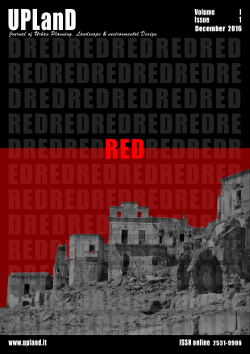RED: hazard, vulnerability, exposure
Main Article Content
Abstract
UPLanD intend to promote an interdisciplinary approach to town and regional planning, landscape and environmental design as an effective form of the governance - sustainable and eco-efficient - of processes for the protection, enhancement and development of urban contexts. The first issue, entitled RED, intended to bring attention to the topic of risks in built and natural environment. Risks are a consequence of hazards, but also and above all, of vulnerability and exposure. But, while hazards are usually part of the environment, exposure and vulnerability originate from three main reasons: ignorance or underestimation of hazards; the belief of being able to managing to their effects; the indifference towards a distant and hypothetical risk as compared to an immediate and concrete benefit. Today the development of adequate policies, the improvement and sharing of best practices, and a careful design research are essential to deal with risks. The very recent seismic events in central Italy furthermore demonstrate the need to immediately focus on the topic
Downloads
Download data is not yet available.
Article Details
How to Cite
SgobboA. (2016). RED: hazard, vulnerability, exposure. UPLanD - Journal of Urban Planning, Landscape & Environmental Design, 1(1), 5. https://doi.org/10.6093/2531-9906/5029
Issue
Section
Articles

This work is licensed under a Creative Commons Attribution-NonCommercial-NoDerivatives 4.0 International License.
Authors who publish with this journal agree to the following terms:- Authors retain copyright and grant the journal right of first publication with the work simultaneously licensed under a Creative Commons Attribution License that allows others to share the work with an acknowledgement of the work's authorship and initial publication in this journal.
- Authors are able to enter into separate, additional contractual arrangements for the non-exclusive distribution of the journal's published version of the work (e.g., post it to an institutional repository or publish it in a book), with an acknowledgement of its initial publication in this journal.
- Authors are permitted and encouraged to post their work online (e.g., in institutional repositories or on their website) prior to and during the submission process, as it can lead to productive exchanges, as well as earlier and greater citation of published work (See The Effect of Open Access).
References
D’Ambrosio, V., & Leone, M. F. (2015). Climate change risks and environmental design for resilient urban regeneration. Napoli Est pilot case. TECHNE-Journal of Technology for Architecture and Environment, 10, 130-140.
Fabietti, V. (1999). Vulnerabilità e trasformazione dello spazio urbano. Firenze, IT: Alinea Editrice.
Losasso, M. (2015). Urban regeneration: innovative perspectives. TECHNE Journal of Technology for Architecture and Environment, 11, 4-5. doi:10.13128/Techne-17492
Moccia, F. D. (2012). Urbanistica. Interpretazioni e processi di cambiamento. Napoli, IT: Clean.
Moccia, F.D. & Sgobbo, A. (2013), La polarizzazione metropolitana. L'evoluzione della rete della grande distribuzione verso un sistema policentrico sostenibile. Napoli, IT: Liguori.
Russo, M. (2014). Can cities be recycled? A different growth for contemporary territories. Italiana, 1, 19-25.
Sgobbo, A., & Moccia, F. D. (2016). Synergetic Temporary Use for the Enhancement of Historic Centers: The Pilot Project for the Naples Waterfront. TECHNE Journal of Technology for Architecture and Environment, 12, 253-260. doi:10.13128/Techne-19360
Sgobbo, A. (2016). Recycling, waste management and urban vegetable gardens. WIT Transactions on Ecology and The Environment, 202, 61-72. doi:10.2495/WM160071
Tira, M. (2015). Pianificazione urbanistica e sicurezza. INGENIO, 33. http://www.ingenio-web.it/Articolo/2929/Pianificazione_urbanistica_e_sicurezza.html
Fabietti, V. (1999). Vulnerabilità e trasformazione dello spazio urbano. Firenze, IT: Alinea Editrice.
Losasso, M. (2015). Urban regeneration: innovative perspectives. TECHNE Journal of Technology for Architecture and Environment, 11, 4-5. doi:10.13128/Techne-17492
Moccia, F. D. (2012). Urbanistica. Interpretazioni e processi di cambiamento. Napoli, IT: Clean.
Moccia, F.D. & Sgobbo, A. (2013), La polarizzazione metropolitana. L'evoluzione della rete della grande distribuzione verso un sistema policentrico sostenibile. Napoli, IT: Liguori.
Russo, M. (2014). Can cities be recycled? A different growth for contemporary territories. Italiana, 1, 19-25.
Sgobbo, A., & Moccia, F. D. (2016). Synergetic Temporary Use for the Enhancement of Historic Centers: The Pilot Project for the Naples Waterfront. TECHNE Journal of Technology for Architecture and Environment, 12, 253-260. doi:10.13128/Techne-19360
Sgobbo, A. (2016). Recycling, waste management and urban vegetable gardens. WIT Transactions on Ecology and The Environment, 202, 61-72. doi:10.2495/WM160071
Tira, M. (2015). Pianificazione urbanistica e sicurezza. INGENIO, 33. http://www.ingenio-web.it/Articolo/2929/Pianificazione_urbanistica_e_sicurezza.html

